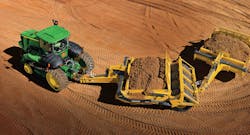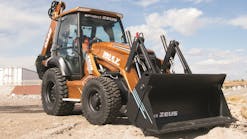Ready for winter? Consider what happened several years ago at one construction site that wasn’t prepared for the erosive impact of winter storms on exposed, disturbed ground.The 30-ac. site was located on hilly land in a suburb of Portland, OR, where heavy rains are much more common in the winter than snow is. A residential subdivision was being built on a former pasture, just below an established residential development. In fact, the main street of an existing development dead-ended at the top edge of the pasture and there were no catch basins to collect stormwater runoff. That pasture sloped in two directions, at about a 2:1 gradient, to different, sensitive streams at the bottom. Before, the pasture’s vegetation had protected the field from being eroded by rainfall and by stormwater running onto it from the dead-end street. However, excavation had completely stripped the field, leaving it bare and unprotected.“In January, the area was hit with a deluge,” recalls Fred Wright, who directs the erosion control program for the Unified Sewerage Agency, based in Hillsboro, OR. “There were no BMPs [best management practices] at the top of the former pasture to divert stormwater from the existing street and no BMPs to prevent soil movement. As a result, stormwater runoff washed tons of soil into the two streams, and it carved gullies up to about 4 feet deep and left two existing landscaped yards filled with half a foot of mud. It was an ugly sight. The developer spent approximately $35,000 to clean up the sediment, repair the damage, and install proper erosion prevention measures.”As authorities in many areas of the country start to tighten up enforcement of rules and regulations protecting the environment, the importance of controlling erosion and sediment at construction sites will only increase. Grading and excavating work can lead to soil erosion and pollution of air and water with sediment just about any time of the year, given the right conditions. In some areas of the country, as in Portland, rain is the main erosion concern in the winter. In other regions, subfreezing temperatures might hold soil particles in place during much of the winter. Often, though, periodic thawing temperatures and runoff from melting snow can erode exposed slopes. Even shutting a site down for the winter doesn’t eliminate the need to protect disturbed soils from winter’s wind, rain, and snow.Denis Lovely, a construction manager with the Maine Department of Transportation in Augusta, has witnessed the consequences of not stabilizing highway construction sites for winter prior to shutdown. “I’ve seen slopes slump and shear right away, producing massive mudslides and turning streams brown and muddy. In the spring you have to get all the heavy equipment back on the site. It’s time-consuming to clean up the mess and repair the damage. It can be quite costly.”Such threats to profits are increasing in many areas as developers and other landowners seek to shorten the interval between breaking ground and generating cash from the newly developed property. Milder weather the past few years has also encouraged grading and excavation contractors in northern areas to work more in the winter than they might have a few years ago. In the Louisville, KY, area, grading and excavation contractors work in the winter if they can, reports Larry Pardue Jr., construction enforcement officer with the Jefferson County Metropolitan Sewer District. “Some winters the weather can be terrible. Other winters can be like a long spring. Last winter, we didn’t have more than about an inch of snow.”The district’s 14-day rule requires stabilizing bare areas at construction sites if there has been no earth-disturbing activities the previous two weeks. Acceptable protective materials include mulch straw, erosion control blankets, or grass, such as winter wheat. Grass is the most popular choice, Pardue notes.“Usually it’s more economical to go with some type of permanent erosion control, such as winter wheat, fescue, or rye,” he states. “August to late November is a good time to seed and establish a good stand of grass in this area. We want all swales on-site vegetated and all easements finished to grade and flowing correctly. That, plus the 14-day rule, tends to get sites pretty well vegetated and prepared for winter.”Working in Wet WintersWright reports, however, that winter construction activity in Washington County in the metropolitan Portland area has been decreasing. In part, he says, that reflects his department’s efforts to educate grading and excavating contractors and developers about the added expenses of working during soggy winters.“Often they overlook the tremendous cost of inspecting and maintaining erosion and sediment control measures at an active construction site during wet weather,” notes Wright, a Certified Professional in Erosion and Sediment Control (CPESC). For sites in the seven-city area within the Unified Sewerage Agency’s jurisdiction, that includes covering all ground disturbed by construction activities at the end of the day.A number of factors can cause soil-disturbing construction activities to extend into winter. That’s where scheduling the work to allow enough time for all the necessary permits can pay off. In Washington County, for instance, previous development has pushed new subdivision projects into hilly areas and higher up in watersheds near critical headwaters and sensitive streams. Earthmoving activities there might require permits from a number of agencies, such as the Oregon Division of Lands, the Oregon Department of Fish and Wildlife, and the US Army Corps of Engineers. Obtaining all the necessary permits can lengthen total turnaround time to as long as three months. In addition, factors such as an active construction market or a lack of review staff can stretch a municipality’s normal 15-day plan review and permit-issue turnaround to a month or longer.The inability to compact wet soils for construction and the high cost of remediating any erosion and sediment damage pretty much rule out mass grading and balancing cuts and fills during the winter in the Portland area, Wright notes. In the case of a subdivision, however, it’s still possible to excavate for roads and utilities in wet weather to offset the cost of delaying other work until the arrival of spring and drier weather.“Contractors are coring out streets, loading the excavated dirt on dump trucks standing next to the work area on rock, and either stockpiling the material on-site and covering it with 6-mil plastic or taking it to landfills that accept dirt,” he reports. “After carving out the roads, they’re laying down a gravel sub-base to stabilize them. They’re also backfilling utility trenches at the end of each day with gravel so that the whole width of the road has a gravel cover on it.”In the Unified Sewerage Agency’s area, the requirement to protect all disturbed soil daily is in effect throughout the wet weather. That period currently runs from October 15 to the following April 30. In addition, all seeding applications must be completed by September 1. This requirement provides a two-month window to establish a vegetative cover before the winter rains begin.“If sites are seeded by that date and the proper soil amendments are included, we usually get at least 80% establishment of a good, healthy stand by November 1,” Wright states. “If not, all bare areas must be covered with straw, mulch, erosion control blankets, or other suitable erosion prevention measures.”Sites not meeting that or other erosion and sediment control requirements receive a deficiency notice. Failure to correct deficiencies in a timely manner can then result in a stop-work order, a civil citation, or both. Violators may also be fined up to $1,000 per incident. For example, a failed sediment fence would count as one incident. A gravel construction site entrance badly contaminated with sediment would be a second incident, and bare soil would be a third incident. The penalty for all three could total as much as $3,000.The most popular material for protecting bare soil is a uniform 2-in.-thick layer of straw. “We’ve seen tremendous advantages to just using basic straw,” Wright observes. “Hay, chopped up and blown on, is prone to movement by wind or water unless an appropriate tackifier is applied. The longer, coarser lengths of straw will hold in place when wet or crimped into the soil.”
Typically, a straw covering is combined with other practices to control erosion and sediment generated from runoff. These measures may change, however, as construction work alters the topography and the resulting direction and force of stormwater runoff. For example, in addition to a 2-in. covering of straw, erosion and sediment control measures might include other BMPs, such as horizontal dozer tracks, sediment fence, or terracing depending on the length and gradient of the slope. On a 4:1 slope, the spacing between sediment barriers installed on contours might be 100 ft. On a 2:1 slope, the interval might be just 25 ft.Working in Cold, White WintersIn snow country and other areas characterized by long spells of mostly subfreezing temperatures, preparing construction sites for winter calls for a different approach. But the idea is still the same: establish vegetation as soon as possible. Depending on climate, that might be in the fall or in the spring.“You increase the potential for erosion at a construction site by removing vegetation,” says Bill Agnew, CPESC, of Reveg Environmental Consulting in Lehi, UT. “So the sooner you get it back, the sooner you can reduce the potential for excessive erosion.“Seed your permanent or temporary vegetation in the fall. That avoids waiting in the spring for soils to dry enough to bring in seeding equipment and captures the full benefit of winter and spring moisture to get plants off to an earlier start.”For winter shutdown, soil and seed on all slopes should be protected, with particular emphasis on slopes steeper than 3:1. One option might be blowing on straw, followed by crimping or spraying with a tackifier to hold the straw in place, Agnew offers. The increased erosion protection, offered by a bonded fiber matrix or erosion control blankets, however, might make them better choices, depending on the erodibility of the soils and the steepness of the slope.Fall is also the time to put sediment control measures in place. In areas of high snowfall, Agnew recommends using low-profile practices, such as straw wattles or artificial dam devices, because taller structures, such as unreinforced silt fence, can collapse under the weight of deep snow. In some cases, however, chainlink fencing or other materials can be used to strengthen the ability of silt fence to remain standing in the spring.When construction activity continues into the winter in cold climates, Agnew advocates minimizing the amount of soil disturbed and left unprotected at any given time. “It’s difficult to justify a temporary cover if soil remains frozen. If the soil is subject to freezing and thawing, however, sediment control measures might be needed with muddy haul roads. A low-cost temporary cover, such as hydromulch or a tackifier, might be appropriate treatment for slopes. But you have to take extra precautions to prevent hydroseeding equipment, used to apply the materials, from freezing up.”While it’s a challenge, keeping water flowing through hydroseeding equipment in subfreezing temperatures can be done, assures erosion control contractor Bob Arello of Hydrograss Technologies in North Oxford, MA. He recalls two midwinter slope stabilization jobs his company did last winter. One involved about 7 ac. of high, very steep, bare slopes on a construction project in Marlboro, MA. Water leaching out of the hillsides was carrying large amounts of sediment down the slopes and into a stream. The project owner wanted to quickly cover the disturbed soils. The rough surface of the slope ruled out the use of erosion control blankets, because water could use the surface irregularities to flow under the blanket, causing more erosion.Hydrograss Technologies was called in to spray a bonded fiber matrix-a blend of wood fibers and special tackifiers-over the bare slopes to hold the soil in place. By that time, however, the air temperature was in the 15°-20°F range. Using the tower gun on their 3,300-gal. hydroseeding rig, Arello’s crew kept the thick slurry in the machine agitating continuously as they applied the material. When they finished spraying, they quickly flushed out the slurry.“The bonding agent in the material was absorbed about one-fourth inch into the bare, frozen ground and set up almost instantly in the cold temperatures,” Arello recalls. “A few weeks later, during a thaw, we hydroseeded rye grass with hydromulch over the bonded fiber matrix. The material greatly reduced fugitive soil particles, and the rye germinated in the spring. Everything held up well. I would do it again.”
Arello also used the same bonded fiber matrix last winter to stabilize about 20 ac. of bare clay slopes at a golf course project in Quincy, MA. Thawing temperatures and rain had eroded the slopes, creating a big sediment control problem before two weeks of frigid air froze the soil in place. Erosion control blankets could not be installed, because the staples, used to anchor the blankets, could not be driven into the frozen, unprotected ground. Arello reports that it took his crews, using two hydroseeding trucks and working with wind-chill factors as low as about -30°F, about a week to complete the job.Working in Wet and White WintersIn Maine, where many bridge construction and road improvement projects extend into the next year, grading and excavating contractors face a wide range of winter weather conditions. Southern and midcoastal areas of the state normally receive rain but little snow. Winters in northern Maine, by contrast, typically include significant snow depths and deep frost. In between these extremes, midwinter rainstorms in other areas might drop several inches of rain, melting the snow cover and producing heavy runoff.“Last winter was fairly warm, and contractors pretty much worked right through winter,” observes Joyce Noel, environmental engineer for the Maine Department of Transportation’s Construction Division.Until 1998, winter erosion control practices on active Maine DOT projects consisted mostly of blowing on hay mulch once a week or so. “Usually the mulch wasn’t applied very thickly,” Noel notes. “Even with fairly high application rates, wind from cars and trucks passing through the sites would blow off the mulch, resulting in a lot of bare areas.”Now requirements for winter erosion and sediment control on Maine DOT projects are much more strict. In addition to covering all disturbed slopes by November 1, contractors must develop a plan to temporarily control erosion and sediment through the winter. Those plans must include measures that divert runoff from rain or snowmelt away from disturbed soils and protect these soils from coming in contact with water. This includes covering any bare, exposed soils at the end of each day’s work.Water diversion practices may include a curb at the top of the slope that directs runoff to a plastic-lined downspout, a pipe, or a channel lined with riprap, depending on slope length and gradient.Whether a site is closed down for the season or construction proceeds through the winter, disturbed soils must be covered with suitable materials. They include a 3-in.-thick application of hay mulch (twice the rate used the rest of the year) on 4:1 or flatter slopes. On several projects at windy sites, a biodegradable netting has been stapled over the hay mulch to keep the mulch from blowing away.“The openings in the net were large enough so that birds and other wildlife wouldn’t get trapped in it,” adds Maine DOT’s Lovely.On steeper slopes, where erosion is a greater threat, choices include erosion control blankets or woodwaste mulch. A byproduct of paper production, woodwaste mulch is a mixture of small pieces of bark and woodwaste and dirt. In the past, it has been disposed of in landfills. When used for permanent erosion and sediment control, this material is seeded with grass or other vegetation. “The woodwaste mulch holds heat and moisture to improve seed germination and establishment,” explains Lovely.The application rate of woodwaste mulch varies from 6 in. thick on 3:1 slopes up to 12 in. thick on slopes as steep as 1.5:1. When used on steep slopes, the woodwaste mulch must be stabilized at the base of the slope with riprap, Noel points out. “Regardless of the materials used to cover the slope, it’s important to install practices, such as a silt fence, at the foot of the slopes to keep any sediment that might erode from washing into a water resource.”She says that Maine DOT encourages contractors to install permanent erosion and sediment control measures as soon as possible to minimize the amount of disturbed soils requiring temporary measures. For one thing, a contractor is paid for each cubic yard of woodwaste mulch or the amount of erosion control blankets or other materials applied for permanent erosion control.Also, Maine DOT owns the slope as soon as it is permanently stabilized. That ends the contractor’s liability should the permanent erosion and sediment control measures fail later. “Contractors bid temporary erosion and sediment control measures as a lump-sum item,” Noel says. “So it behooves them to use as few temporary practices as possible. Most contractors time their projects so they can minimize the need for temporary erosion and sediment control practices. At the end of the day, they put the woodwaste mulch on a finished grade, and the state owns the slope up to that point. The next day, the contractor keeps going up the slope.”







